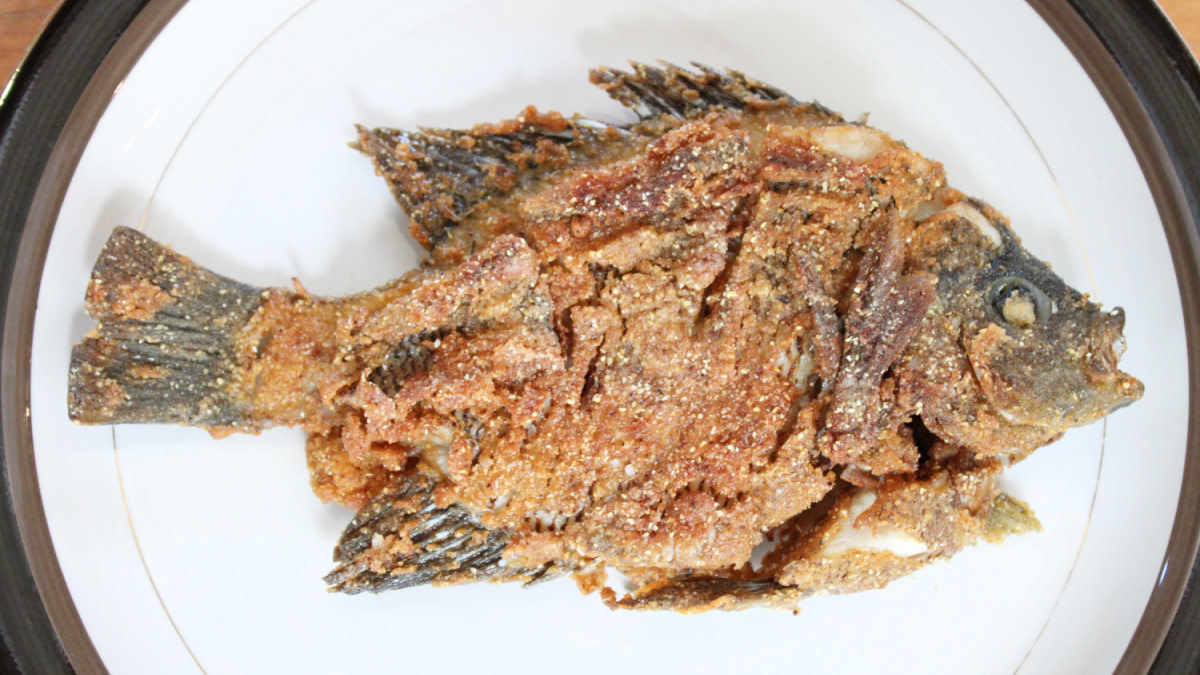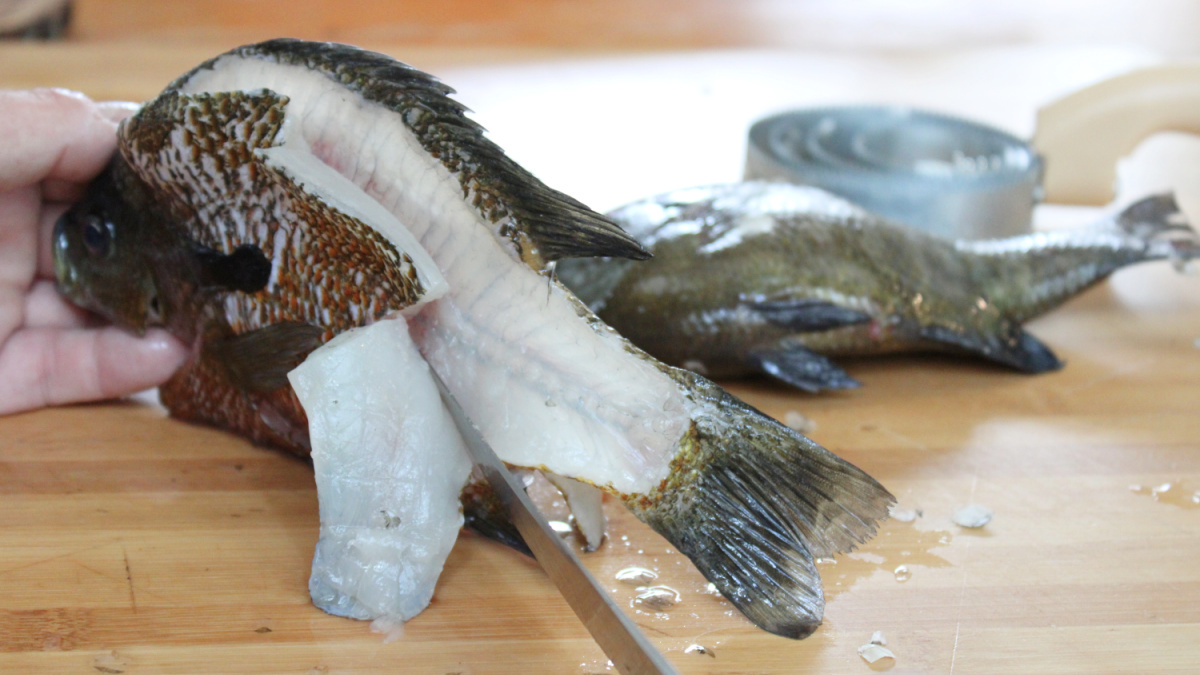
Duration
1 hour
Serves
4
This preparation of a whole, crispy panfish riffs heavily off the concept of the bloomin’ onion. The fish is scaled and gutted, then the fillets are slightly cut away from the body (but make sure to leave them still attached). The goal here is to expose some of the flesh and create more surface area for breading. Check out the picture of the bluegill below to see what I mean.
This eater-friendly version of the whole-fried fish is a favorite at my restaurant, Dai Due. We serve bluegills along with other sunfish that I commercially catch in local lakes and rivers during the summer months.
My customers love this preparation—I'm confident you will too.

Ingredients
- 8 to 12 panfish
- 1 cup buttermilk
- 1 cup mustard
- 3 to 4 cups fine cornmeal, fish fry mix, or seasoned flour
- Preferred sauces for serving
Also works with
Special equipment
Preparation
-
Scale the fish. I like a curry comb for speed, but a spoon or fish scaler will work perfectly well too. I also wear a cut-resistant glove when scaling, not necessarily for protection, but more for grip when processing a pile of slippery summer panfish. Make sure to scale the throat area and the top and bottom of the tail.
-
Gut the fish. Run the tip of a knife from the anus all the way forward to the gills. Scoop out all of the guts and pull out the gills. Alternately, you can remove the head entirely. Make sure you leave the prodigious meat around the forehead by angling the cut foreword, especially if using larger sunfish species like bluegills and redears that have a lot of meat up here.
-
Fillet the fish. Make a cut from the top down on either side of the fish’s spine, following the backbone closely. If you miss a little meat here, no worries at all because it will still be on the bone-side after cooking. Cut down to the rib cage and then disconnect the fillet from the tail, leaving just the area of the rib cage attached. Next, make two or three vertical cuts through the fillet, creating three or four “fish fingers” that are still attached to the rib cage.
-
Dredge the fish. I love a 50/50 mix of buttermilk and mustard. Any mustard will work, and if you don’t have any buttermilk, use yogurt or sour cream thinned with milk, or just milk. Take the time to get this wet mix in between the fillets and backbone, and also in between the vertical cuts you’ve made. Next, dredge the fish in your favorite fish fry mix, which could simply be finely ground cornmeal, a commercial product, or seasoned flour. Again, make sure that this dry mix gets in between all the cuts you’ve made. You can complete this step up to a few hours before frying, just keep the fish refrigerated.
-
Fry the fish. Heat your oil or fat to 350°F. I like lard or beef tallow, but peanut oil or any other frying oil will work well. Fry the fish until it turns golden brown, about 4 to 6 minutes depending on size. If you want the fins nice and crispy, maybe take it a little beyond to get that “fish chip” effect. Serve with tartar sauce, spicy mayonnaise, or cocktail sauce.
Sign In or Create a Free Account
This preparation of a whole, crispy panfish riffs heavily off the concept of the bloomin’ onion. The fish is scaled and gutted, then the fillets are slightly cut away from the body (but make sure to leave them still attached). The goal here is to expose some of the flesh and create more surface area for breading. Check out the picture of the bluegill below to see what I mean.
This eater-friendly version of the whole-fried fish is a favorite at my restaurant, Dai Due. We serve bluegills along with other sunfish that I commercially catch in local lakes and rivers during the summer months.
My customers love this preparation—I'm confident you will too.

Ingredients
- 8 to 12 panfish
- 1 cup buttermilk
- 1 cup mustard
- 3 to 4 cups fine cornmeal, fish fry mix, or seasoned flour
- Preferred sauces for serving
Also works with
Special equipment
Preparation
-
Scale the fish. I like a curry comb for speed, but a spoon or fish scaler will work perfectly well too. I also wear a cut-resistant glove when scaling, not necessarily for protection, but more for grip when processing a pile of slippery summer panfish. Make sure to scale the throat area and the top and bottom of the tail.
-
Gut the fish. Run the tip of a knife from the anus all the way forward to the gills. Scoop out all of the guts and pull out the gills. Alternately, you can remove the head entirely. Make sure you leave the prodigious meat around the forehead by angling the cut foreword, especially if using larger sunfish species like bluegills and redears that have a lot of meat up here.
-
Fillet the fish. Make a cut from the top down on either side of the fish’s spine, following the backbone closely. If you miss a little meat here, no worries at all because it will still be on the bone-side after cooking. Cut down to the rib cage and then disconnect the fillet from the tail, leaving just the area of the rib cage attached. Next, make two or three vertical cuts through the fillet, creating three or four “fish fingers” that are still attached to the rib cage.
-
Dredge the fish. I love a 50/50 mix of buttermilk and mustard. Any mustard will work, and if you don’t have any buttermilk, use yogurt or sour cream thinned with milk, or just milk. Take the time to get this wet mix in between the fillets and backbone, and also in between the vertical cuts you’ve made. Next, dredge the fish in your favorite fish fry mix, which could simply be finely ground cornmeal, a commercial product, or seasoned flour. Again, make sure that this dry mix gets in between all the cuts you’ve made. You can complete this step up to a few hours before frying, just keep the fish refrigerated.
-
Fry the fish. Heat your oil or fat to 350°F. I like lard or beef tallow, but peanut oil or any other frying oil will work well. Fry the fish until it turns golden brown, about 4 to 6 minutes depending on size. If you want the fins nice and crispy, maybe take it a little beyond to get that “fish chip” effect. Serve with tartar sauce, spicy mayonnaise, or cocktail sauce.






